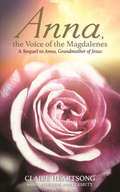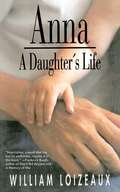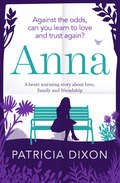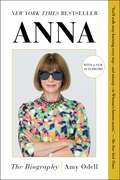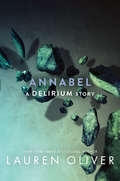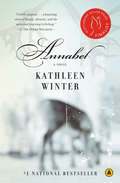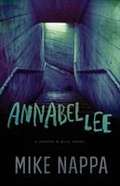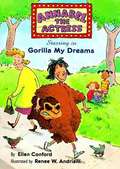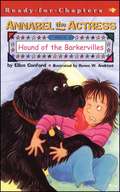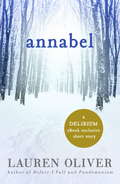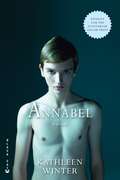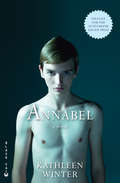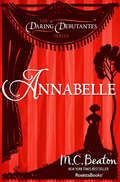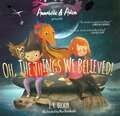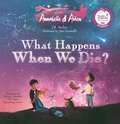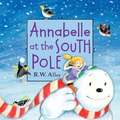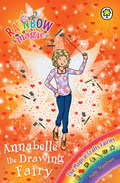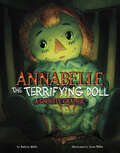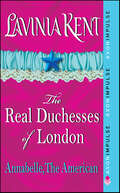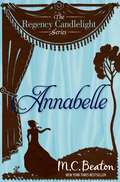- Table View
- List View
Anna, the Voice of the Magdalenes: A Sequel to Anna, Grandmother of Jesus
by Claire HeartsongIn this channelled sequel to the international bestseller Anna, Grandmother of Jesus, we journey with Anna, the Holy Family and 18 other Magdalene–Essenes as they travel to France and Britain after Jesus’s crucifixion and resurrection.This book gives a completely new perspective on the gnostic Mount Carmel Essene mystery school, in which Jesus and Mary Magdalene took initiations, as well as on the Holy Family and the Magdalene Order. Through Claire Heartsong, Anna tells not only the story of Jesus, but also the story of the women who surrounded him throughout his life. The book reveals the deeper mysteries they have safeguarded for aeons of time, including aspects of Jesus’s personal life not recorded in history – his relationships and, most radically, his offspring.In this one-of-a-kind story, Claire shares the information she received from Anna on the ‘Seeding of Light’ – the dispersion of Anna, Mother Mary and Jesus’s enlightened descendants whose ‘bloodline’ acts as a living catalyst for the awakening of the Christ–Magdalene potential today. Not only does this book give a new view of the Christ drama 2,000 years ago but, more importantly, it offers the potential to lift the suppressed Divine Feminine voice in our time.
Anna-daan, Food Charity in India: Preaching and Practice
by K. V. Raju S. ManasiEating together unites people and has a significant impact on their physical, social, and emotional development. This book looks at practices and traditions of sharing food prevalent among major religious communities in India, including Hinduism, Buddhism, Jainism, Sikhism, Christianity, and Islam.Food insecurity is one of the major problems every country in the world is facing today because of increasing population, climate change, agrarian distress, wars and conflicts, and the COVID-19 pandemic. Including case studies from across India, this book examines the necessity and effectiveness of food-sharing practices in temples, mosques, and gurudwaras, among others. Emphasising the importance of these practices for the social and physical well-being of the most vulnerable sections of society, it showcases how traditional religious practices of food sharing have contributed to tackling hunger, especially during the COVID-19 pandemic. The volume also offers long-term solutions to address underlying issues which cause hunger and food insecurity.One of the first to study food sharing and alms-giving practices in India, this book will be an essential read for scholars and researchers of sociology, anthropology, food studies, religion, security studies, political economy, public policy, and South Asian history and culture.
Anna: A Daughter's Life
by William LoizeauxBorn with a number of birth defects known as VATER Syndrome, Anna Loizeaux's chances for survival were uncertain. Each day was a gift and each moment was precious. Much of her brief life was spent in hospital nurseries and operating rooms, where medical technology and human intervention mustered all their resources to give her the chance for life that nature had not. In the end, they couldn't.Anna lived only a few precious, wonderful months, and when she died she shattered the lives of her parents. Where is the design to the death of a child? What is left to hold on to? William Loizeaux began to write a journal. Begun out of the agony of grief and the determination to forget nothing, Anna: A Daughter's Life becomes an affirmation: there is no life without a marker. In the terrible beauty and uncompromising honesty of her father's prose, Anna has her marker. This stunningly beautiful record of a father's grief begun out of isolation and helpless rage, becomes an act of celebration. In it, he finds, and offers to us, the courage and spirit that asked so much from so brief a life. Here is an unforgettable portrait of an unforgettable child that reaches out to us all
Anna: A Heartwarming Story about Love, Family and Friendship (The Destiny Series #2)
by Patricia DixonIn this heartwarming novel, a wife and mother finds her life crumbling around her—until she rediscovers what it means to be a woman in love. For years, Anna has been content to be the rock of her family—stable and reliable, if somewhat unremarkable. Then she discovers that her husband Matthew is having an affair. Consumed by hurt and tainted memories, her life is turned upside down by betrayal and loss. Though Anna is tormented by the shadow of Matthew&’s unknown lover, she keeps the secret of his affair from her family, With one son on the other side of the world, another about to enter a war zone, and her daughter off to university, Anna must find her way through the pain alone. Her life gradually begins to crumble until someone from her past appears . . . But can Anna find peace and learn to love again?
Anna: The Biography
by Amy OdellThis definitive New York Times bestselling biography of Anna Wintour, now featuring a new afterword, follows the steep climb of an ambitious young woman who would—with singular and legendary focus—become one of the most powerful people in media.As a child, Anna Wintour was a tomboy with no apparent interest in clothing but, seduced by the miniskirts and bob haircuts of swinging 1960s London, she grew into a fashion-obsessed teenager. Her father, an influential newspaper editor, loomed large in her life, and once he decided she should become editor-in-chief of Vogue, she never looked back. Impatient to start her career, she left high school and got a job at a trendy boutique in London—an experience that would be the first of many defeats. Undeterred, she found work in the competitive world of magazines, eventually embarking on a journey to New York and a battle to ascend, no matter who or what stood in her way. Once she was crowned editor-in-chief of Vogue—in one of the stormiest transitions in fashion magazine history—she continued the fight to retain her enviable position, ultimately rising to dominate all of Condé Nast. Named one of Time&’s 100 Must-Read Books of 2022, this in-depth and revealing biography is based on extensive interviews with Anna Wintour&’s closest friends and collaborators. Weaving Anna&’s personal story into a larger narrative about the hierarchical dynamics of the fashion industry and the complex world of Condé Nast, Anna charts the relentless ambition of the woman who would become an icon.
Annabel
by Lauren OliverLena's mother, Annabel, has always been a mystery—a ghost in Lena's past. Until now. Discover her secrets in Lauren Oliver's brilliant original digital story set in the world of New York Times bestsellers Delirium and Pandemonium. Lena Halloway's mother, Annabel, supposedly committed suicide when Lena was only six years old. That's the lie that Lena grew up believing, but the truth is very different. As a rebellious teenager, Annabel ran away from home and straight into the man she knew she was destined to marry. The world was different then—the regulations not as stringent, the cure only a decade old. Fast forward to the present, and Annabel is consigned to a dirty prison cell, where she nurtures her hope of escape and scratches one word over and over into the walls: Love.
Annabel (Anansi Book Club Editions Ser.)
by Kathleen WinterShortlisted for the Scotiabank Giller Prize, the Governor General's Award for Fiction, and the Rogers Writers' Trust Fiction Prize In 1968, into the beautiful, spare environment of remote coastal Labrador, a mysterious child is born: a baby who appears to be neither fully boy nor girl, but both at once. Only three people are privy to the secret — the baby's parents, Jacinta and Treadway, and a trusted neighbour, Thomasina. Together the adults make a difficult decision: to raise the child as a boy named Wayne. But as Wayne grows to adulthood within the hyper-masculine hunting culture of his father, his shadow-self — a girl he thinks of as "Annabel" — is never entirely extinguished, and indeed is secretly nurtured by the women in his life. Haunting, sweeping in scope, and stylistically reminiscent of Jeffrey Eugenides' Middlesex, Annabel is a compelling tale about one person's struggle to discover the truth about their birth and self in a culture that shuns contradiction. Now featuring a preview of Kathleen Winter's nonfiction work, Boundless: Tracing Land and Dream in a New Northwest Passage.
Annabel Lee: A Coffey and Hill Novel (Coffey and Hill #1)
by Mike NappaFourteen miles east of Peachtree, Alabama, a secret is hidden. The secret's name is Annabell Lee She doesn't know why her enigmatic uncle has stowed her deep underground in a military-style bunker. He's left her with a few German words, a barely controlled guard dog, and a single command: "Don't open that door for anybody, you got it? Not even me." Miles away in Atlanta, private investigator Trudi Coffey is visited by a mysterious older man calling himself Dr. Smith. He's been trailing a man for a decade—a man she met through her ex- partner Samuel Hill—and the trail has led him to her office. The last thing Trudi wants to do is to contact Samuel. But it will take both of them to unravel this mystery—before it's too late. MIKE NAPPA is an entertainment journalist at FamilyFans.com, as well as a bestselling and award- winning author with more than one million books sold worldwide. When he was a kid, the stories of Edgar Allen Poe scared him silly. Today he owns everything Poe ever wrote. A former fiction acquisitions editor, Mike earned his MA in English literature and now writes full time.
Annabel the Actress, Camping It Up
by Ellen ConfordAnnabel is dead set on becoming a famous actress. When the camp play calls for auditions, she is only too happy to try out for the big part. Annabel clinches it with her blood-curdling screams, and she thinks this gig just might be her big break. But soon she learns there's more to the acting life than fame and fortune. And when a garden snake worms his way onstage opening night, it's up to Annabel to make sure that the show must go on!
Annabel the Actress, Starring in Gorilla My Dreams
by Ellen ConfordThough a little disappointed that her first acting part is to be a gorilla at a birthday party, Annabel determines to really get into the role.
Annabel the Actress, Starring in Just a Little Extra
by Ellen ConfordWhen she learns that a famous director is making a movie in her hometown, ten-year-old Annabel is determined to get a part in it.
Annabel the Actress, Starring in the Hound of the Barkervilles
by Ellen ConfordWhen Annabel, who wants to be a famous actress someday, has a part in a real play, she finds she must cope with a big dog and an unruly audience member.
Annabel: A Delirium Short Story
by Lauren OliverLena's mother, Annabel, has always been a mystery - a ghost in Lena's past. Until now. Discover her secrets in Lauren Oliver's brilliant original digital story set in the world of international bestsellers Delirium and Pandemonium. Through chapters that alternate between her past and present, Annabel reveals the true story behind her failed cures, her marriage, the births of her children, her imprisonment, and, ultimately, her daring escape. You can also take an early look at the first few chapters of REQUIEM - the final installment in Lauren Oliver's stunning internationally bestselling Delirium series.
Annabel: A Novel
by Kathleen WinterBorn into the beautiful wilderness of north-eastern Canada, Wayne was raised as a boy despite not being born fully male nor female. But as Wayne grows, and as he becomes aware of the hyper-masculine culture of his family, his emotional demands to be a woman begin to cry out.
Annabel: A Novel (Anansi Book Club Editions Ser.)
by Kathleen WinterAn “absorbing . . . beautifully written” debut about the trials of growing up unique in a restrictive environment (The New York Times Book Review). In 1968, in a remote part of Canada, a child is born—a baby who appears to be neither fully boy nor girl, but both at once. Only three people share the secret: the baby’s parents and a trusted neighbor. Together, the adults make the difficult choice of deciding the gender for themselves, and raise the child as a boy named Wayne. But as Wayne grows up, his shadow-self, a girl he thinks of as “Annabel,” is never entirely extinguished, and indeed is secretly nurtured by the women in his life. As Wayne approaches adulthood, and its emotional and physical demands, the woman inside him begins to cry out. The changes that follow are momentous not just for him, but for the three adults who have guarded his secret. Shortlisted for the Orange Prize in Fiction, this “enchanting” literary gem explores the courage to unveil one’s true self in a culture that shuns contradiction (The New Yorker).
Annabelle (The Daring Debutantes Series #5)
by M. C. BeatonIn this Edwardian romance by the New York Times–bestselling author of the Agatha Raisin mysteries, an optimistic debutante faces an unlucky season.It&’s a maiden&’s miracle! Annabelle Quennell, daughter of a poor country parson, gets a chance at a London Season to snare a wealthy husband. But before she sets off, Mad Meg the Gypsy predicts trouble ahead! And it is nothing but woe that Annabelle finds. Godmother Lady Emmeline sponsors Annabelle&’s spree—and demands she wed the oafish Capt. MacDonald. But things get worse when Annabelle fears she is losing her heart to Lord Varleigh—elegant, well-pursed, but who is taken by another mistress! What a pickle Annabelle had gotten into, and it only gets more sour by the moment…ABOUT THE COLLECTION The seven heroines of the Daring Debutantes Collection set out to conquer London&’s glittering high society and the marriage mart. These headstrong women cannot help but keep London society dangling on a string, but will they find a husband or lose themselves in the game?
Annabelle + Aiden: Oh, The Things We Believed!
by J. R. BeckerIn this delightful illustrated book written in rhyme, the children gaze at a face-shaped cloud, and Aiden asks if it is real. To answer, our favorite feathered-dinosaur, the Skeptisaurus, guides the children to use their critical thinking skills when determining myth from fact. He takes the kids on an amazing journey through legends of old times, from witches to oracles, explaining how we evolved to see things that aren't always there. But when those myths vanish, they see that real scientific discovery is just as exciting, and can change the world. The children learn that "real answers may not be magic, but they are always magical."
Annabelle and Aiden What Happens When We Die
by J. R. BeckerIn this inspiring, life-affirming tale, Annabelle asks, “What happens when we die?” Aiden dreams of an afterlife with marshmallow shoes and chocolate kangaroos. But with the help of their dear friends like the Skeptisaurus and Tardigrade Tom, the children discover what we do know, and how worth celebrating it is. How our atoms rejoin the universe, which remains forever changed by our lives. How our energy lasts forever, along with the stories of our loved ones we keep alive by honoring their memories. And most of all, how mortality can inspire us to appreciate the incredible opportunity we've been given: to live the best, most meaningful lives we can, surrounded by the people we love.
Annabelle at the South Pole
by R. W. AlleyAnnabelle is trapped inside on a cold, wintry afternoon with her brothers and sister. When they won’t stop pestering her, she sets off into the snowy backyard in search of adventure, and soon finds herself at the South Pole in the company of an abominable (but adorable) snowman. This magical winter story joins Clark in the Deep Sea, Gretchen Over the Beach, and Mitchell on the Moon in a four-book series that celebrates the power of imagination, created by the veteran children’s book illustrator R. W. Alley.
Annabelle the Drawing Fairy: The Magical Crafts Fairies Book 2 (Rainbow Magic #2)
by Daisy MeadowsGet ready for an exciting fairy adventure with the no. 1 bestselling series for girls aged 5 and up. Rachel and Kirsty return to Rainspell Island for Crafts Week. They're so excited try all of the workshops. But after the Magical Crafts Fairies' items are stolen, all types of crafts are in chaos. Jewellery will keep breaking, artists won't be able to draw properly and paint will come out grey! Can they help the Magical Crafts Fairies get them back before Crafts Week is ruined? 'These stories are magic; they turn children into readers!' ReadingZone.com Read all seven fairy adventures in the Magical Crafts Fairies set! Kayla the Pottery Fairy; Annabelle the Drawing Fairy; Zadie the Sewing Fairy; Josie the Jewellery-Making Fairy; Violet the Painting Fairy; Libby the Story-Writing Fairy; Roxie the Baking Fairy. If you like Rainbow Magic, check out Daisy Meadows' other series: Magic Animal Friends and Unicorn Magic!
Annabelle the Terrifying Doll: A Ghostly Graphic (Ghostly Graphics Ser.)
by Andrew WolfeIn 1970, a nursing student was given a large doll as a gift. Soon, the doll—which became known as Annabelle—began acting strangely. When no one was looking, Annabelle changed positions on its own. Then the doll began leaving creepy, cryptic notes asking for help. Was Annabelle possessed by the spirit of a dead girl? Or was the doll an anchor for a demon? Young readers will find out in this easy-to-read ghostly graphic novel that will send shivers down their spines!
Annabelle's Sketchbook of Dreams
by Oliver PengilleyAnnabelle's Sketchbook of Dreams is an inspiring book based on real-life events. A daughter’s imagination and love for drawing helps to bring joy to her father who has become bedridden. Sketching her dreams in a book given to her by her father, she goes on many adventures with her cat Naomi, encouraging other children to draw, paint and write to fill the world with joy. The illustrations in this book are done by the father and his daughter who was three years old at the time of creating this book. They hope it inspires other children and parents when things get tough during life-changing circumstances.
Annabelle, The American: The Real Duchesses of London
by Lavinia KentRegency England just got real(ity)Episode 3: Annabelle and the terrible, horrible, no good, very bad rumorAnnabelle, Marchioness of Tattingstong, always thought she was a good wife. She’s put up with all thetitters and stares in the ballroom that go along withbeing a rich American married only for her wealth andlooks. But, when it’s rumored that her husbandhas a secret family, one he is using her money to keep,Annabelle may have finally had enough. A properEnglish wife would grin and bear it, but playing bysociety’s rules hasn’t worked for her so far.Will revenge be as sweet as American pie?
Annabelle: Regency Candlelight 1 (Regency Candlelight)
by M.C. BeatonThe first book in M.C. Beaton's charming Regency Candlelight trilogy. It's a maiden's miracle! Annabelle Quennell, daughter of a poor country parson, gets a chance at a London Season to snare a wealthy husband. But before she sets off, Mad Meg predicts trouble ahead! And it is nothing but woe that Annabelle finds. Godmother Lady Emmeline sponsors Annabelle's spree - and demands she wed the oafish Capt. MacDonald. But things get worse when Annabelle fears she is losing her heart to Lord Varleigh - elegant, well-pursed, but who is taken by another mistress! What a pickle Annabelle has gotten into, and it only gets more sour by the moment!Blessed with beauty, Mrs. Manners has never bothered with the more practical (and to her, lesser) skills of grammar and spelling. So it is, in order to snag a second husband, namely the handsome Duke of Denbigh, she needs the help of Miss Verity Bascombe. Surely the modest chit would be honored to help write her love letters. Poor Verity! Her old school-girl friend remains as selfish as ever. But the lovely girl's gilded pen soon has the duke most intrigued by the poetic Mrs. Manners! But alas, what begins as a seemingly minor deception becomes a larger problem and Verity soon finds herself enamored of the handsome duke, wanting him all for herself!The heroines of the Regency Candlelight Series set out to conquer London's glittering high society and marriage mart. These headstrong women cannot help but keep London society dangling on a string, but will they find a husband or lose themselves in the game?'Romance fans are in for a treat' - Booklist'[M. C. Beaton] is the best of the Regency writers' - Kirkus Reviews
